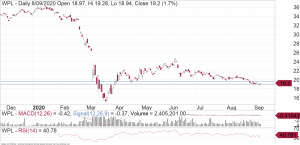We recently reviewed Woodside Petroleum (ASX:WPL) after the Company reported its results for the six months to 30 June 2020 (1H20). With the share price continuing to fall despite some strong fundamental drivers, at what point does WPL become an attractive opportunity?
About Woodside Petroleum
WPL is an Australian-based exploration and production company. It has a portfolio of producing oil & gas assets. It is the largest independent oil and gas producer in Australia. The Company’s two flagship LNG operations are North West Shelf (‘NWS’, where WPL has operatorship and an equal 16.67% stake with its six partners) and Pluto (where WPL has operatorship and a 90% interest).
Growth projects in Australia include Greater Enfield, Browse FLNG, Sunrise FLNG, and NWS LNG Tolling. International growth includes Myanmar, Senegal, and Kitimat. In 2019, Woodside’s total production was 89.1 million barrels of oil equivalent. It was split between oil and condensate (17%), liquefied natural gas (LNG) (73%), liquefied petroleum gas (LPG) (4%), and natural gas (6%).
Key Fundamental Drivers
Impact From Higher Spot LNG Sales Likely to Reverse
WPL’s earnings in 1H20 were impacted by an unusual spike in spot LNG cargoes during 2Q20. This was because LNG buyers flexed down the amount of contract LNG purchased. In turn, this increased WPL’s exposure to the weak spot LNG market. Here prices have recently been trading at lows of ~US$2.20/MMBtu.
In comparison to its peers, WPL is the most leveraged to spot LNG prices. They account for ~25% of overall LNG sales. This figure compares to Oil Search’s 5% and Santos’ 1%. While WPL’s earnings are strongly leveraged to an improvement in LNG prices, the Company’s higher spot LNG exposure is unlikely to be viewed positively by the market until LNG prices recover. There are two factors supporting the view that spot LNG prices are likely to increase from recent lows:
i. The US Energy Information Administration (EIA) expects that rising demand heading into the northern 2020 winter, combined with reduced production, will cause upward price pressures. EIA forecasts that Henry Hub natural gas spot prices will average $2.03/MMBtu in 2020 and $3.14/MMBtu in 2021.
ii. LNG prices are likely to spike from 2022-2025 in the wake of supply side delays. In particular, from under-construction LNG projects which have been delayed as a result of COVID-19. In context, a US$1/MMBtu change in spot price would increase FY21 EBITDA by 5-6%.
Investors Split on Scarborough Development
WPL’s current strategy for Scarborough gas field (located in the Carnarvon Basin) is the development of the Burrup Hub to bring the offshore Scarborough and Browse gas resources through WPL’s existing assets – Pluto LNG (where WPL is the operator) and the NWS Project. The Company is targeting first LNG cargo in 2024. Approval of Pluto Train 2 (WPL: 90%) is increasingly certain. This is given that WPL now has gas at Scarborough, with a Final Investment Decision (FID) due this year.
However, some in the market remain cautious of the current strategy. They question the need for a new LNG liquefaction facility at Pluto when NWS ullage is due to emerge in late 2021/2022. Further, investors do not seem convinced that Browse is economic, or marketable, or low carbon. An alternative view held by some is that WPL should process gas from Scarborough via the NWS plant. This plan is considered a lower-risk development for the NWS and more economically viable. However, the challenge in processing gas from Scarborough at NWS is improved alignment of NWS JV partners. According to management comments in July 2020, this may not take place until late 2021.
Balance Sheet Well Managed … But Could Come Under Pressure
WPL’s gearing ratio is 19.4% as at 30 June 2020. It remains within the target range of 15-35%. It is also well below debt covenants. There is ample balance sheet headroom. This is especially given that gearing is likely to be pressured by recent/prospective acquisitions.
Fundamental View
We consider that there are a number of catalysts over the coming 12 month for WPL. These include higher spot LNG prices, large Merger & Acquisition opportunities (in particular Chevron’s 16.7% stake in NWS), and further clarity on the path to an FID for Scarborough.
WPL remains committed to its LNG expansion projects. However, recent commodity price declines create uncertainty as to the timelines whether they proceed. Having said that, when the eventual recovery in commodity prices takes effect, we consider that the Company is in a strong position to recommence expansion programs. This is because of its strong balance sheet position, low operating cost structure, and favourably low expansion capital intensity due to costs already sunk.
However, it is worth noting that realising the potential upside (and bridging the currently large gap to market valuations) is likely to take time, especially as the market’s patience with WPL and management’s ability to deliver has worn thin after years of missed growth targets.
Charting View
WPL peaked in early June and then the share price slowly declined ever since. The pace of the decline is slowing down. Unfortunately it is lacking any momentum so there is always a risk that it could slide a bit further in the short term. Otherwise these are the levels where WPL may start to turn higher again. If we can see a strong day or two for WPL from here, then that would be the signal that support is going to hold and it would also indicate the start of a rally. At the moment though we just need to wait for that buy signal.














